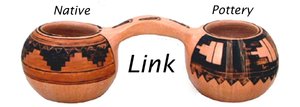
Navajo Pottery
Native American Navajo Olla by Samuel Manymules, a superb potter whose work is growing in popularity. He has won ribbons at the Santa Fe Indian Market for several years. He shows the continuing evolution of Navajo pottery to more sophisticated forms and more refined finishes.
Samuel’s pots are made traditionally, but reflect contemporary design concepts in large bean pots, melon pots, and dough bowls. They usually are polished smooth with a slip of piñon pitch. Iron oxide is often added to give the pot a red-brown tinge.
Please Note: For a limited time, our normal fee for packing and shipping this work of pottery art within the 48 mainland United States will be absorbed by Native-PotteryLink, resulting in FREE SHIPPING to any qualifying address. Shipping to other destinations may be
Pi76 Navajo Samuel Manymules olla with swirled bowl under stovepipe upper. 10" x 6"
$900.00
Native American Navajo Olla by Samuel Manymules, a superb potter whose work is growing in popularity. He has won ribbons at the Santa Fe Indian Market for several years. He shows the continuing evolution of Navajo pottery to more sophisticated forms and more refined finishes.
Samuel Manymules was born in 1963, of the Bitterwater Clan for the Red House Clan. He occasionally refers to himself as “Leumas” Manymules, a spelling of his first name in reverse.
His pottery is now fairly easy to find as a result of his growing renown. The pot shown here was an early work acquired from him by us driving to the reservation to meet him in a parking lot.
Samuel Manymules claims he taught himself how to make pottery by looking at the pottery of Joseph Lonewolf and Christine McHorse in books. His genre is minimalist pottery with an amazing sense of form.
Samuel’s pots are made traditionally, but reflect contemporary design concepts in large bean pots, melon pots, and dough bowls. They usually are polished smooth with a slip of piñon pitch. Iron oxide is often added to give the pot a red-brown tinge.
10" x 6" #Pi76
Please Note: For a limited time, our normal fee for packing and shipping this work of pottery art within the 48 mainland United States will be absorbed by Native-PotteryLink, resulting in FREE SHIPPING to any qualifying address. Shipping to other destinations may be
arranged through Sanibelart@gmail.com
See Additional Info for a video of Manymules describing his "Perfect World" bowl. And for an insight into Samuel’s approach to pottery making, in his own words.


Additional Info
Samuel Manymules at Wheelwright Museum, Santa Fe

